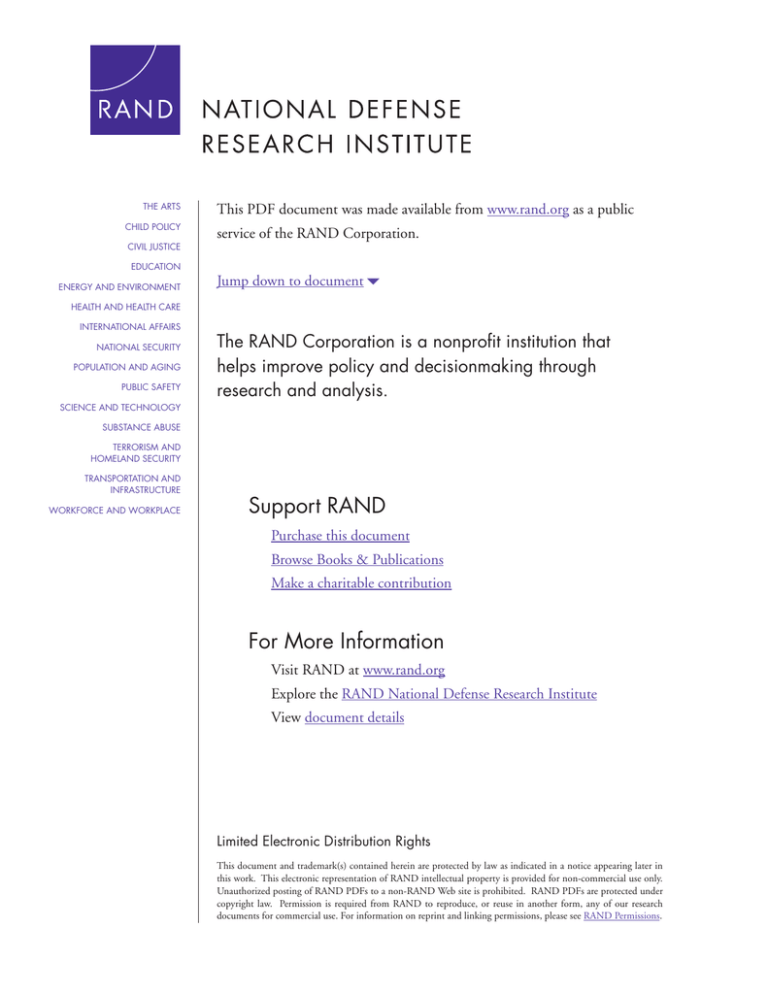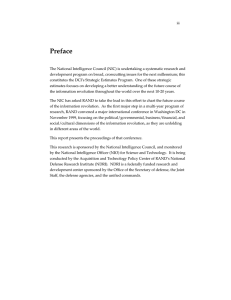6 om as a public service of the RAND Corporation.
advertisement

THE ARTS CHILD POLICY CIVIL JUSTICE EDUCATION ENERGY AND ENVIRONMENT This PDF document was made available from www.rand.org as a public service of the RAND Corporation. Jump down to document6 HEALTH AND HEALTH CARE INTERNATIONAL AFFAIRS NATIONAL SECURITY POPULATION AND AGING PUBLIC SAFETY The RAND Corporation is a nonprofit institution that helps improve policy and decisionmaking through research and analysis. SCIENCE AND TECHNOLOGY SUBSTANCE ABUSE TERRORISM AND HOMELAND SECURITY TRANSPORTATION AND INFRASTRUCTURE WORKFORCE AND WORKPLACE Support RAND Purchase this document Browse Books & Publications Make a charitable contribution For More Information Visit RAND at www.rand.org Explore the RAND National Defense Research Institute View document details Limited Electronic Distribution Rights This document and trademark(s) contained herein are protected by law as indicated in a notice appearing later in this work. This electronic representation of RAND intellectual property is provided for non-commercial use only. Unauthorized posting of RAND PDFs to a non-RAND Web site is prohibited. RAND PDFs are protected under copyright law. Permission is required from RAND to reproduce, or reuse in another form, any of our research documents for commercial use. For information on reprint and linking permissions, please see RAND Permissions. This product is part of the RAND Corporation technical report series. Reports may include research findings on a specific topic that is limited in scope; present discussions of the methodology employed in research; provide literature reviews, survey instruments, modeling exercises, guidelines for practitioners and research professionals, and supporting documentation; or deliver preliminary findings. All RAND reports undergo rigorous peer review to ensure that they meet high standards for research quality and objectivity. Developing a Defense Sector Assessment Rating Tool Agnes Gereben Schaefer, Lynn E. Davis, Ely Ratner, Molly Dunigan, Jeremiah Goulka, Heather Peterson, K. Jack Riley Prepared for the Office of the Secretary of Defense Approved for public release; distribution unlimited N ATI O NA L D EF ENSE R E S E A R C H I N S T I T U T E The research described in this report was prepared for the Office of the Secretary of Defense (OSD). The research was conducted in the RAND National Defense Research Institute, a federally funded research and development center sponsored by OSD, the Joint Staff, the Unified Combatant Commands, the Navy, the Marine Corps, the defense agencies, and the defense Intelligence Community under Contract W74V8H-06-C-0002. Library of Congress Control Number: 2010935903 ISBN: 978-0-8330-5030-4 The R AND Corporation is a nonprofit institution that helps improve policy and decisionmaking through research and analysis. RAND’s publications do not necessarily reflect the opinions of its research clients and sponsors. R® is a registered trademark. © Copyright 2010 RAND Corporation Permission is given to duplicate this document for personal use only, as long as it is unaltered and complete. Copies may not be duplicated for commercial purposes. Unauthorized posting of RAND documents to a non-RAND website is prohibited. RAND documents are protected under copyright law. For information on reprint and linking permissions, please visit the RAND permissions page (http://www.rand.org/publications/ permissions.html). Published 2010 by the RAND Corporation 1776 Main Street, P.O. Box 2138, Santa Monica, CA 90407-2138 1200 South Hayes Street, Arlington, VA 22202-5050 4570 Fifth Avenue, Suite 600, Pittsburgh, PA 15213-2665 RAND URL: http://www.rand.org To order RAND documents or to obtain additional information, contact Distribution Services: Telephone: (310) 451-7002; Fax: (310) 451-6915; Email: order@rand.org Summary The U.S. government spends billions of dollars annually on foreign assistance. Foreign assistance programs span many agencies, including the U.S. Department of State (DoS), the U.S. Agency for International Development (USAID), and the U.S. Department of Defense (DoD). There is currently a variety of assessment tools and frameworks to assist in the design of foreign assistance programs and allocation of resources.1 However, there is no comprehensive tool to assist policymakers in assessing the state of the defense sector in a given country, to provide them with a systematic way of determining a country’s capabilities to achieve various security goals that the U.S. government may have, or to monitor the success of defense sector programs over time. This study aimed to fill that gap and design the Defense Sector Assessment Rating Tool (DSART). The DSART can be found at the end of this report. For the purpose of the DSART, the defense sector is defined as the uniformed military, plus the military and civilian management, accountability, and oversight systems, mechanisms, and processes that sustain it. U.S. Goals For Defense Sector Reform The United States could have a variety of goals for defense sector reform in a given country. One goal could be to support the country in its efforts to better manage its own security problems and potentially partner with the United States and other countries in international military operations. Such reforms would involve the country changing its defense institutions and processes to include those capacities that the United States views as critical for effective military planning and operations (e.g., civilian control of the military, military professionalism). Another set of goals could be to improve the country’s ability to counter specific threats and improve its own internal security and thereby contribute to U.S. security. These threats could include terrorism and insurgency, drug trafficking, porous land or sea borders, piracy, and instability in the aftermath of a conflict. Foreign assistance that seeks to promote this set of U.S. goals could involve improving a country’s military capabilities for surveillance and interdiction, training its military in counternarcotics or counterterrorism operations, and helping establish processes for military coordination with civilian law-enforcement organizations. The structure of the DSART flows directly from these potential goals for defense sector reform. 1 See the appendix for a list of assessment tools. ix x Developing a Defense Sector Assessment Rating Tool Structure of DSART The first section of the DSART sets the stage for the subsequent assessments, and the assessor is asked to answer questions about the characteristics of the defense sector in a country. The focus areas and questions were drawn from the many assessment tools that are used by the U.S. government, foreign governments, international organizations, and nongovernmental organizations (NGOs) to assess countries’ security or defense sectors. The introductory section is followed by six assessments, the first of which focuses on the country’s defense institutions and processes and how they match up with a set of capacities that the United States views as “critical” in any defense sector. These capacities are defined in various U.S. government documents. The DSART assessor is asked to provide a qualitative appraisal and then a quantitative score of the country’s “critical” capacities on a scale of 1 (entirely lacking) to 5 (strong and no major improvement needed). Once the deficiencies in capacities have been identified, the section ends by asking a series of questions about the prospects for reforming those areas in which deficiencies were found. The end result is an assessment that identifies deficiencies in the country’s defense institutions and processes, as well as an assessment of the prospects for reform in the deficient areas. The subsequent sections in the DSART assess the country’s capabilities to carry out operations to counter high-priority internal security threats (terrorism and insurgency, drug trafficking, porous land or sea borders, piracy, and instability in the aftermath of a conflict). The research team drew from U.S. government planning documents, historical case studies, and discussions with subject-matter experts to identify a list of “critical functions” necessary to respond to each of these security threats. In these sections, the assessor is asked to provide a qualitative appraisal and then a quantitative score of the country’s capabilities to carry out these “critical” functions on a scale of 1 (entirely lacking) to 5 (strong and no major improvement needed). Once the deficiencies in capabilities have been identified, the sections end by asking a series of questions about the prospects for reforming those areas in which deficiencies were found. The end results identify deficiencies in the country’s capability to conduct counterterrorism and counterinsurgency, counternarcotics, border and maritime security, counterpiracy, or postconflict stabilization operations and provide an assessment of the prospects for reform in the deficient areas. The Way Ahead The DSART can play a vital role in assisting U.S. policymakers in identifying deficiencies in a country’s defense sector and then prioritizing and allocating foreign assistance resources. Once U.S. policymakers decide that a country’s defense sector will need to be assessed, a decision will also need to be made about which assessment tools are most appropriate for their goals. For instance, the DSART could be used by itself or in combination with other assessment tools, such as the Criminal Justice Sector Assessment Rating Tool, depending on what issues policymakers are most interested in understanding. Once it is decided that the DSART should be used to assess a country’s defense sector, the assessor always fills out Section One of the DSART, “Characteristics of the Defense Sector.” The assessor then completes those assessments that are applicable to the chosen goals. In some cases, only one of these assessments may be applicable to the country; in other cases, multiple assessments may need to be com- Summary xi pleted because the United States has multiple goals. The completed DSART assessment is then returned to U.S. policymakers, who review it and use it as background for deciding whether to undertake defense sector reforms and how resources should be allocated for those reforms. The initial DSART assessment of a country’s defense sector should be viewed as only the starting point for what will need to be a series of activities, potentially over many years, that will involve programs and follow-on assessments. The DSART, in its structured set of questions and assessments of critical defense sector capacities and the capabilities needed to meet different types of internal security threats, is similar to the assessment tools of other U.S. government agencies and multinational organizations. The DSART does, however, lend itself to being used for a more formal and systematic assessment of these capacities and capabilities. To this end, the assessor could take additional steps to validate the information that is collected, e.g., answering the questions in the DSART through structured interviews, holding workshops with a cross-section of local experts, or conducting tabletop exercises for the qualitative evaluations. The DSART could be used by countries other than the United States to assess either their own defense sector capabilities or those of countries to which they are providing assistance. The DSART could also be used by multilateral organizations to assess the countries to which they are or may wish to provide assistance. While the DSART is now ready for use, U.S. goals for defense sector reform may evolve. The DSART is designed with a flexible architecture so that it can be adapted to a changing security environment. Our goal is that the tool will continue to evolve as it is used in different countries and with different goals in mind.




